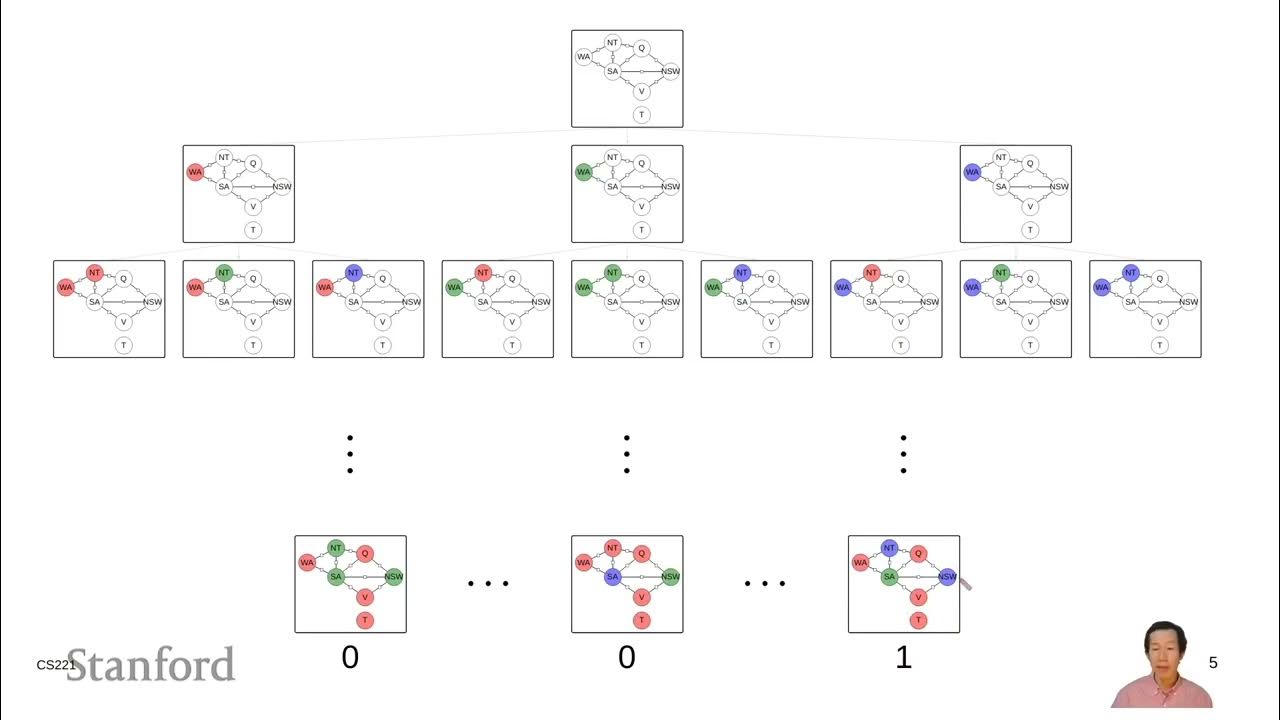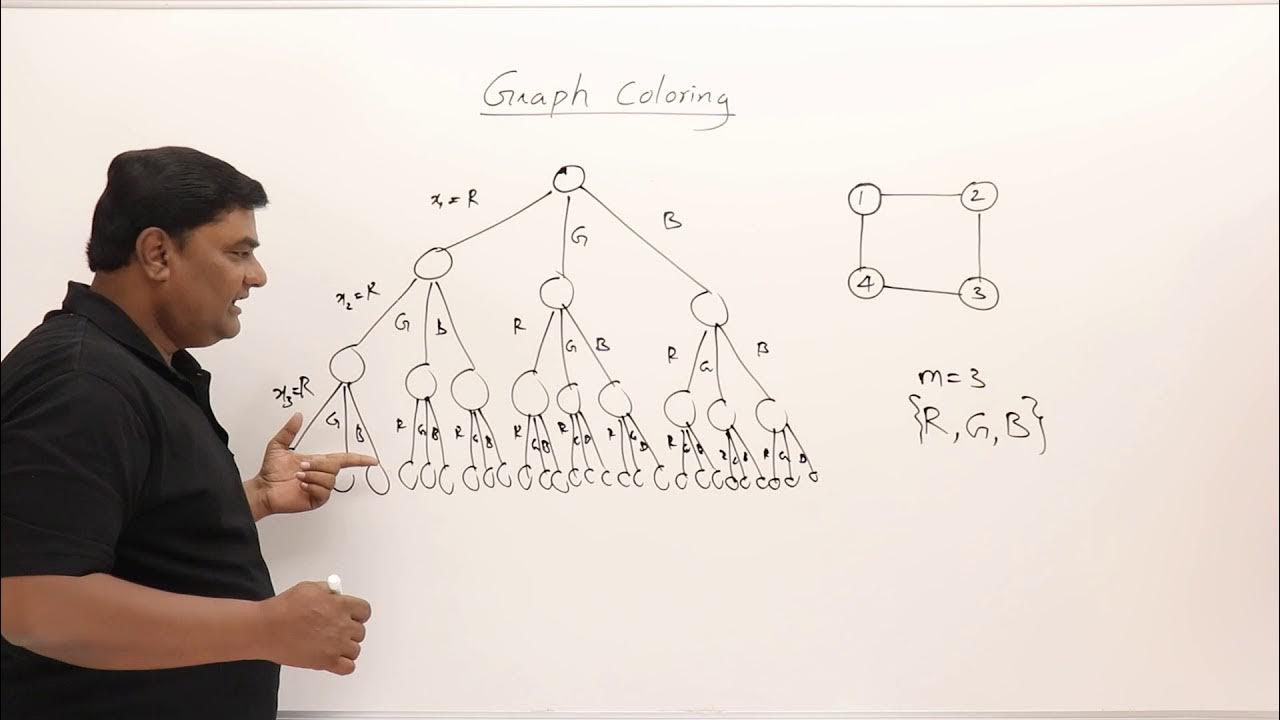Constraint Satisfaction Problems (CSPs) 2 - Definitions | Stanford CS221: AI (Autumn 2021)
Summary
TLDRThis video script introduces the concept of factor graphs and constraint satisfaction problems through examples like a voting scenario and map coloring. It explains how variables and factors represent unknown quantities and constraints/preferences, respectively. The script emphasizes the local specification of constraints and the global optimization of assignments, aiming to find the maximum weight assignment that satisfies all conditions.
Takeaways
- 📊 The script introduces the concept of constraint satisfaction problems and factor graphs through examples.
- 🗳️ A voting example is used to illustrate how factor graphs can model relationships and constraints among variables.
- 🔍 Factors in a factor graph represent constraints or preferences, and are functions that return non-negative numbers.
- 👫 The voting example demonstrates how close relationships (e.g., between friends) can influence the agreement of votes.
- 🌐 The scope of a factor is the set of variables it depends on, and the arity is the number of variables in that scope.
- 🎨 The map coloring example shows how factor graphs can be used to solve problems with spatial constraints.
- 📝 The script defines a factor graph as consisting of variables with domains and factors that return non-negative values.
- 🔢 An assignment in a factor graph assigns values to variables, and the weight of an assignment is the product of factor outputs for that assignment.
- 🚫 A constraint-satisfaction problem aims to find the assignment with the maximum weight, indicating consistency and satisfaction of all constraints.
- 🧩 The script explains that factors can have different weights, not just 0 or 1, allowing for a spectrum of preferences.
- 🔑 The concept of 'specify locally, optimize globally' is highlighted as a key advantage of using factor graphs for modeling complex problems.
Q & A
What is a constraint satisfaction problem?
-A constraint satisfaction problem is a type of problem where a set of variables must be assigned values from a given set, subject to a set of constraints. The goal is to find an assignment of values that satisfies all constraints.
What is a factor graph and how is it related to constraint satisfaction problems?
-A factor graph is a graphical model that consists of variables and factors. Variables represent unknown quantities, and factors represent constraints or preferences for partial assignments. Factor graphs are used to model and solve constraint satisfaction problems by providing a structure to represent the relationships between variables and constraints.
Can you explain the voting example given in the script using factor graphs?
-The voting example illustrates a scenario with three people, each voting either blue or red, with certain constraints on their votes. A factor graph is used to model this by defining variables for each person's vote and factors that represent the constraints, such as person one voting blue, person three leaning red, and the agreement between person one and two.
What is the purpose of factors in a factor graph?
-Factors in a factor graph capture constraints or preferences for the variables. They are functions that take assignments to the variables as input and return a non-negative number, indicating the degree to which the assignment satisfies the constraint or preference.
How are the weights of assignments calculated in a factor graph?
-The weight of an assignment is calculated by taking the product of the outputs of all the factors in the factor graph when the assignment is plugged into them. If any factor returns 0, the weight of the assignment is 0, indicating inconsistency.
What does it mean for an assignment to be consistent in the context of factor graphs?
-An assignment is consistent if its weight is greater than 0, meaning that none of the factors in the factor graph return 0 for that assignment, and thus all constraints are satisfied.
What is the objective of solving a constraint satisfaction problem using a factor graph?
-The objective is to find the maximum weight assignment, which is the assignment of values to variables that results in the highest product of factor outputs, indicating the most satisfying solution to the constraints.
What is the difference between a constraint and a factor in the context of factor graphs?
-A constraint is a specific type of factor that returns 0 or 1, representing a strict yes or no condition. Factors, in general, can return any non-negative number, representing varying degrees of preference or satisfaction.
Can you provide an example of a unary factor and a binary factor in a factor graph?
-A unary factor has an arity of 1, meaning it depends on a single variable. For example, a factor that specifies that person one must vote blue. A binary factor has an arity of 2, meaning it depends on two variables, such as a factor that requires the votes of person one and person two to agree.
What is the significance of the term 'scope' in relation to factors in a factor graph?
-The scope of a factor refers to the set of variables that the factor depends on. It is visually represented by the variables that the factor is connected to in the graph, and it determines which variables are relevant to the factor's constraint or preference.
How does the map-coloring example in the script relate to factor graphs?
-The map-coloring example demonstrates how to use a factor graph to model a problem where each region must be assigned a color without any two adjacent regions sharing the same color. Variables represent the regions, and factors represent the constraints that neighboring regions must have different colors.
Outlines

Esta sección está disponible solo para usuarios con suscripción. Por favor, mejora tu plan para acceder a esta parte.
Mejorar ahoraMindmap

Esta sección está disponible solo para usuarios con suscripción. Por favor, mejora tu plan para acceder a esta parte.
Mejorar ahoraKeywords

Esta sección está disponible solo para usuarios con suscripción. Por favor, mejora tu plan para acceder a esta parte.
Mejorar ahoraHighlights

Esta sección está disponible solo para usuarios con suscripción. Por favor, mejora tu plan para acceder a esta parte.
Mejorar ahoraTranscripts

Esta sección está disponible solo para usuarios con suscripción. Por favor, mejora tu plan para acceder a esta parte.
Mejorar ahoraVer Más Videos Relacionados

Constraint Satisfaction Problems (CSPs) 1 - Overview | Stanford CS221: AI (Autumn 2021)

Introduction to Constraint Satisfaction Problems (CSP)

Matematika Diskrit - Graf (Graph) - Part 1 - Konsep Umum Graf

6.3 Graph Coloring Problem - Backtracking

Abordagem da Coloração em Grafos | Teoria dos Grafos | 2025.1

Section 1 Worksheet Solutions: CSPs
5.0 / 5 (0 votes)
